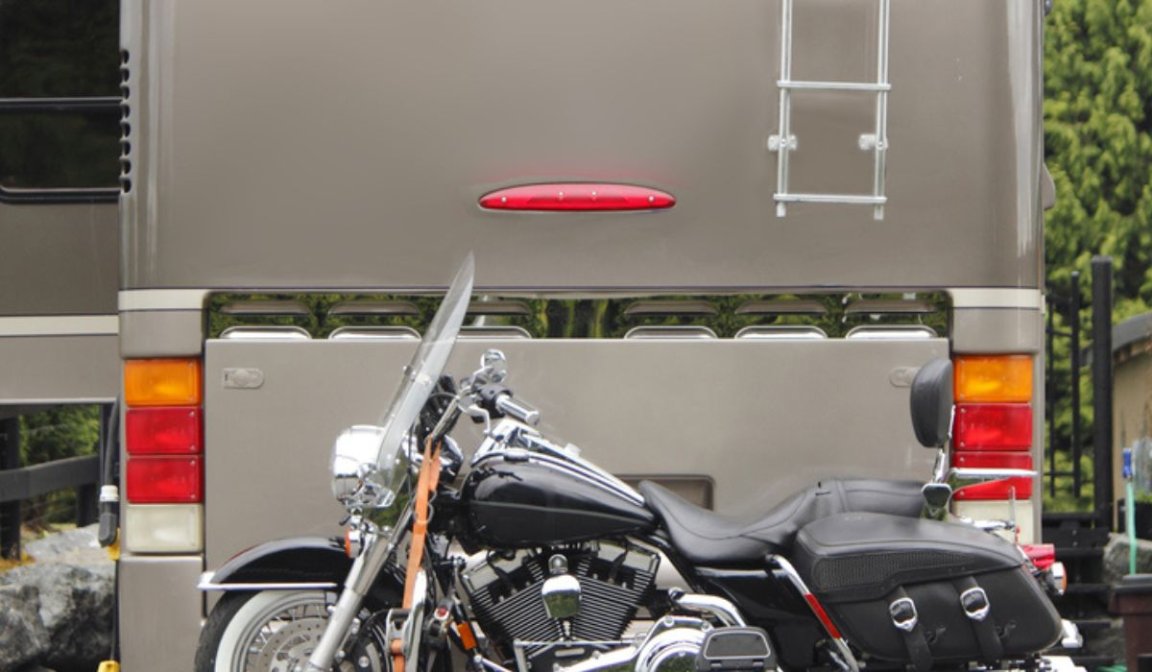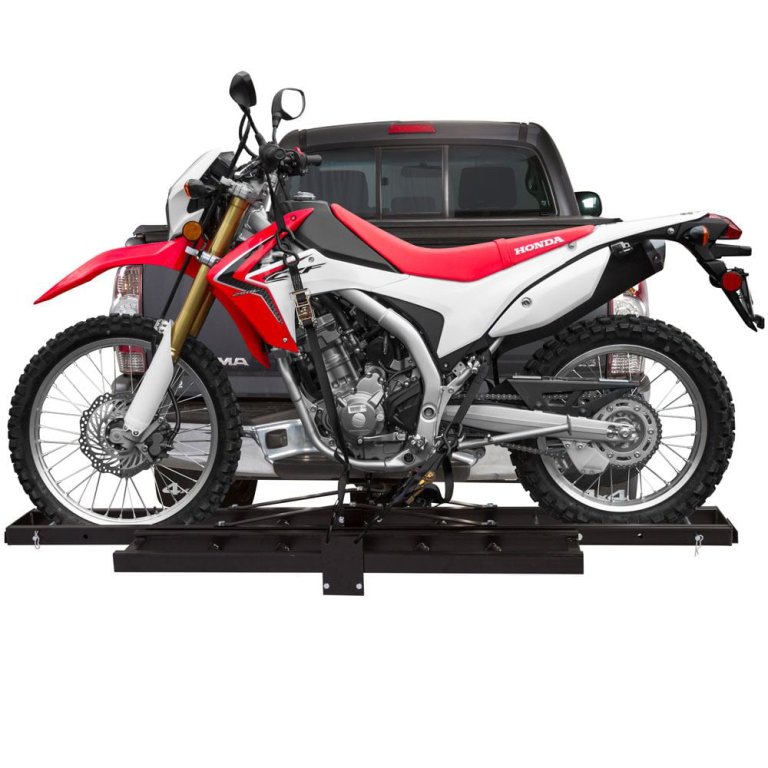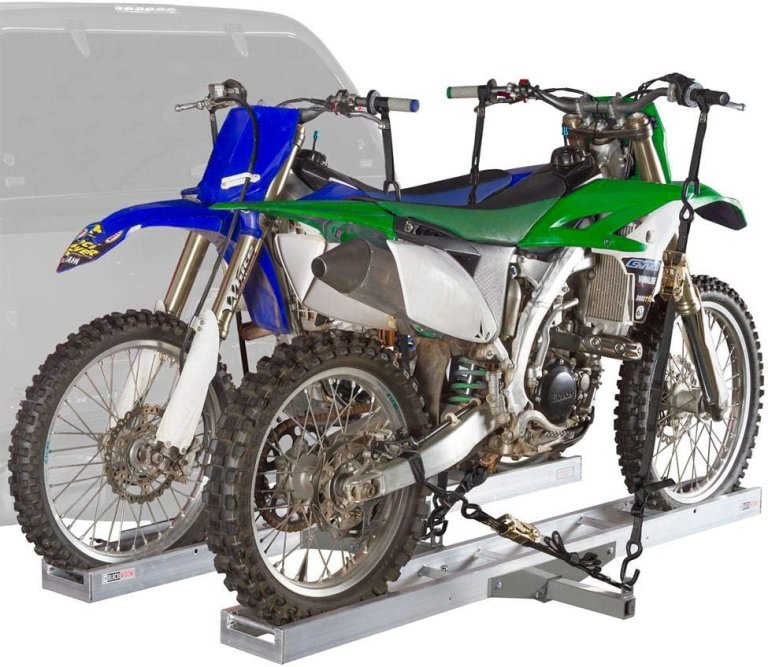We may earn revenue from the products available on this page and participate in affiliate programs. Learn more ›

Do you need to take your kid’s dirt bike to the track for next weekend’s race? Maybe you’re purchasing a motorcycle that needs some work and isn’t yet roadworthy. Perhaps you’re taking that big trek to bike week but don’t want to get saddle sores riding all the way out there. Whatever your reason for wanting to transport your dirt bike or motorcycle, investing in a durable motorcycle hitch carrier is a great space-saving alternative to trailering your bike.
When it comes to selecting the best motorcycle hitch carrier to suit your needs, there are many great options out there. I’ve got you covered with a list of favorites. You’ll be loaded up and ready to roll in no time.
Summary List
- Best Overall: Rage Powersports Black Widow Steel Motorcycle Carrier
- Best Budget: Trackside Motorcycle Carrier
- Best Premium: Black Widow Motorcycle Carrier
- Honorable Mention: BikeMaster Motorcycle Carrier
- Best Tandem: Rage Powersports Black Widow Aluminum Double Motorcycle Carrier
- Most Versatile: TMS Heavy-Duty Motorcycle Hitch Rack Hauler
Our Methodology
Not all motorcycle hitch carriers are created equally, so the top picks for the best models were selected by taking an in-depth look at their construction, design, functionality, and price. Overall reliability and performance, as well as manufacturer reputation and trustworthiness, were also factors in selecting the best bike racks for cars. Only companies with a solid track record of delivering reliable and durable products were chosen for this list. For more information on selection criteria and methods, check out this link, which explains our methodology further.
Best Motorcycle Hitch Carriers: Reviews & Recommendations
Best Overall: Rage Powersports Black Widow Steel Motorcycle Carrier
Pros
- Heavy-duty construction
- Adjustable track
- Self-storing
Cons
- Heavy and can be tough to mount initially
- Ramp is short
The Rage Powersports Black Widow Motorcycle Carrier is tough to beat if you’re looking for a carrier that’s not only rugged, stable, and well-priced but is also compatible with a wide variety of motorcycles, dirt bikes, and scooters. This carrier can handle bikes weighing up to 600 pounds, making it one of the most heavy-duty options on the market. It features durable all-steel construction and a corrosion-resistant black powder-coated finish. It’s compatible with all Class III and Class IV 2.0-inch hitch receivers and comes with a 5/8-inch hitch pin. The adjustable track is a nice touch that allows you to easily accommodate bikes of different sizes. It can also handle bikes with tires measuring up to 7.0 inches or less, making it even more versatile.
Built-in reflectors help you easily be seen by following traffic. The self-storing ramp is also a great feature, although it should be noted that it’s somewhat shorter than some other competitor’s models. Another drawback to this otherwise well-constructed unit is that the bolts aren’t the best quality and may need to be replaced at some point. Weighing in at 64 pounds, this carrier is also one of the heaviest on the list and can be difficult for one person to mount on their own.
Best Budget: Trackside Motorcycle Carrier
Pros
- Solid construction
- Very stable when attached to your hitch
- Affordable
Cons
- Assembly instructions aren’t the clearest
- Only works with tires measuring 4.75 inches or less
When it comes to the perfect combination of high-quality construction and refreshingly low price point, the clear choice for best budget-friendly motorcycle hitch carrier is the Trackside Motorcycle Carrier. This rugged and sleek-looking carrier can easily and reliably support bikes weighing up to 500 pounds. Full-steel construction and an attractive powder-coated finish ensure that it won’t rust or corrode for years to come. One of the best parts: its affordable price. This motorcycle hitch carrier gets high marks for being easy to assemble and easy to install so you can get on the road quickly. A streamlined design and anti-tilt precautions make this a solid choice that won’t have your bike shaking all the way to the track.
This carrier only works with Class III and Class IV hitches. It’s also only capable of carrying bikes with tires measuring 4.75 inches or less. It also loses some love for not having clearer assembly instructions.
Best Premium: Black Widow Motorcycle Carrier
Pros
- Rugged construction without added weight
- Bike can be loaded from either side
- Wide ramp
Cons
- Ramp can be cumbersome to use
- Construction materials include cadmium and lead
The Black Widow MCC-500 Steel Motorcycle Carrier is one of the most heavy-duty and dependable motorcycle hitch carriers on the market. Like many others, it’s constructed from tough steel with a black powder-coating that is rust- and corrosion-resistant. This ergonomic and sleek-looking carrier features a respectable maximum weight capacity of 500 pounds and only weighs 57 pounds. Unlike some others, this carrier has a ramp that can be installed on either side to allow for bilateral loading and unloading. It’s designed for use with Class III and Class IV hitch receivers and includes a 5/8-inch hitch receiver. The built-in anti-rattle device ensures stable and secure transportation of your motorcycle, dirt bike, or scooter.
This unit can accommodate bikes with tire widths up to five inches, which isn’t the most versatile, but is still suitable for a wide variety of makes and models. The design of this carrier can also make it more difficult to roll your bike on and off, versus carriers that feature solid floors. This carrier also loses points for having a more cumbersome ramp than some other options and its construction materials include cadmium and lead.
Honorable Mention: BikeMaster Motorcycle Carrier
Pros
- Affordable price tag
- Solid ramp design
- Simple and quick assembly
Cons
- Ramp is short
- Side bolts seem loose
The BikeMaster Motorcycle Carrier deserves some recognition for being another dependable and super budget-friendly option. It features a 500-pound weight capacity and can accommodate bikes with tire widths up to 5.0 inches or less. This model features a pin-to-ramp clearance of 18.0 inches, which allows it to carry wider bikes with ease without having to worry about your bike rubbing or scratching your vehicle. Like most others, this carrier is designed using all-steel construction with a black powder-coated finish. It’s compatible with all 2.0-inch Class III or IV hitch receivers.
The included ramp features a solid floor, making it easier to roll your bike on and off compared to some other competitors’ models. That said, the ramp is a little on the short side and may be tough to use on vehicles with higher ground clearance. Overall construction quality seems a little less heavy duty than some other options on the list, but for this refreshingly low price point, it’s still a good value.
Best Tandem: Rage Powersports Black Widow Aluminum Double Motorcycle Carrier
Pros
- Can carry multiple bikes
- Large total weight capacity
- Ramp installs on either side
Cons
- Bulky and cumbersome
- Heavy
Double your motorcycle carrying capacity with the tough and rugged Rage Powersports Black Widow Aluminum Double Motorcycle Carrier. This two-bike carrier is capable of accommodating bikes with tires as wide as 5.5 inches, making it even more versatile. With a 600-pound weight limit, you’ll be able to carry a wide variety of bikes. It’s compatible with Class III and Class IV 2.0-inch hitch receivers. For added ease of use, the included ramp can be installed on either side for bilateral loading and unloading.
Even though this carrier is constructed of lightweight aluminum, the dual capacity still makes it one of the heaviest, bulkiest, and most cumbersome options on the list. It’s still a very affordable and easier to use option than a full-size trailer. The aluminum is also not as rugged and rust-resistant as an all-steel, powder-coated finish would be.
Most Versatile: TMS Heavy-Duty Motorcycle Hitch Rack Hauler
Pros
- Ultra affordable
- Lightweight
- Compatible with a variety of hitches
Cons
- Not heavy-duty construction
- Not as stable at high speeds
The TMS Heavy-Duty Motorcycle Hitch Rack Hauler is a great choice if you want a budget-friendly option that will work with Class III, IV, or V 2.0-inch hitch receivers. It features all-steel, powder-coated construction that is capable of carrying up to 500 pounds with ease. It’s also got a user-friendly dual-sided loading ramp for easy on- and off-loading on whichever side you choose. This model also comes equipped with rugged tie-down sites on either side of the carrier so you can securely anchor your bike and not have to worry about it wobbling around while underway.
This carrier loses some points for not being solidly constructed. The hitch insertion seems a little flimsy, and it doesn’t ride with stability at higher speeds. The fact that it’s so lightweight and easy for one person to assemble and install is a selling point. That, coupled with its ultra-low price point are what make this motorcycle hitch carrier a top choice.
Our Verdict on the Best Motorcycle Hitch Carriers
The best motorcycle hitch carrier for your buck is the Rage Powersports Black Widow Steel Motorcycle Carrier. For a heavy-duty budget-friendly model that won’t disappoint, try the Trackside Motorcycle Carrier.
What to Consider When Buying Motorcycle Hitch Carriers
Weight Capacity
As mentioned above, the maximum weight capacity of any motorcycle hitch carrier will be one of the most important features to consider. If you’ve got a heavier, bulkier bike, you’ll likely need a hitch carrier with a capacity of 600 pounds. If you’re schlepping a lightweight dirt bike, this will be less of a concern and you can probably get away with a less expensive, less heavy-duty hitch carrier.
Hitch Compatibility
There are five classes of hitches. They go in order from Class I to Class V. Class I and II hitches have a receiver size of 1.25 inches. These are used on cars, crossovers, and minivans. Higher class hitches are used on trucks and have 2.0-inch receivers and higher weight capacities. Most good motorcycle hitch carriers are compatible with all Class III and IV hitches and 2.0-inch receivers. Some are also compatible with Class V hitches. Check your specs prior to purchase.
Ease of Use
Size, weight, and installation of the hitch carrier should also be key considerations when choosing the best option for you. If you’re going to be installing this unit on your own, be sure it’s something you’re physically capable of lifting and maneuvering. Some hitch carriers weigh as little as 45-50 pounds, while other heavier-duty carriers can weigh as much as 70 pounds or more. Those may not be the best option for single-person installation and use. Be sure to read up on ramp setup and construction. Make sure you get a carrier with a ramp that’s long enough to reach from your hitch to the ground.
Pricing
Most decent hitch carriers will fall in the $150-$250 price range. These will be constructed from powder-coated steel or aluminum and will have a maximum weight capacity of 500-600 pounds. For $250 and more, you’ll get a heavy-duty, rugged hitch carrier that can easily carry 600 pounds and may be able to carry multiple bikes. These will be made from aluminum or steel as well, but the construction will be more substantial overall with higher end components and accessories.
FAQs
You’ve got questions. The Drive has answers.
A: This refers to the weight your hitch can safely hold, specifically, the downward force that can be exerted on your hitch ball without causing failure. The higher the class of hitch, the higher the tongue capacity. Class I: up to 200 pounds; Class II: up to 350 pounds; Class III: up to 800 pounds; Class IV: up to 1,000 pounds; Class V: up to 2,550 pounds.
A: Follow the manufacturer’s installation instructions. Connect the support brackets to your trailer hitch bar before installing the carrier between them. You’ll likely need to install the anti-tilt device and the carrier on the hitch and insert your hitch pin. The ramp goes on last.
A: Secure the front end by tying it down with two ratchet tie-down straps, which have u-hooks. Tie the straps around the middle of the triples on your bike’s forks, so they pull down on the bottom triples. Then fasten the other end of the straps to the carrier. Use two more ratchet tie-down straps to secure the bike’s frame to the hitch, and you’re finished.
A: Whether you can attach a motorcycle hitch carrier to your vehicle depends on whether you can fit a two-inch or 5/8-inch class III or IV hitch receiver. You’ll need to check your vehicle’s specifications to see if this is possible.








